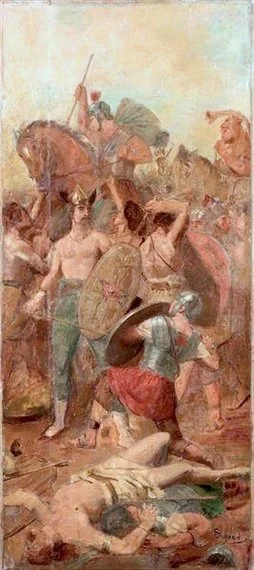Dagobert I ( 603/605-639 CE), a prominent figure in the Merovingian dynasty, ruled as the King of Austrasia (623–634) and eventually as the King of all the Franks (629–639). His reign marked a period of relative unity and administrative consolidation, though it was often marred by political intrigues, external threats, and internal dissent. Dagobert's leadership qualities, political ambitions, strengths, and weaknesses left a lasting imprint on early medieval Europe.
Terry Bailey explains.
Treasures of Dagobert from a 19th century book.
Born into the Merovingian dynasty, Dagobert was the eldest son of King Chlothar II. The political climate of the early 7th century was dominated by internal strife within the Frankish territories, divided into Neustria, Austrasia, and Burgundy. To ensure stability and appease the Austrasian nobles, Chlothar appointed Dagobert as the sub-king of Austrasia in 623 CE. Despite his youth, Dagobert showed an early aptitude for governance and diplomacy, bolstered by his chief advisor, Pepin of Landen, who later became a foundational figure in the rise of the Carolingians.
Upon his father's death in 629, Dagobert sought to consolidate his power over the entire Frankish realm. He deftly neutralized his rivals, including his half-brother Charibert II, who briefly ruled over Aquitaine before being assassinated, likely on Dagobert's orders. By 632, Dagobert was the undisputed ruler of the Frankish kingdoms, a feat rarely achieved in the fragmented Merovingian era.
Dagobert's reign was characterized by his ambition to strengthen royal authority, curtailing the growing power of the Frankish nobility. He implemented significant administrative reforms, sought alliances with powerful aristocrats, and maintained a court that reflected the grandeur of his aspirations.
He was also a patron of the Church, founding several monasteries, including the famed Abbey of Saint-Denis near Paris, which became the royal necropolis of the French monarchy. His support of the Church not only solidified his legitimacy but also provided a moral counterbalance to his often ruthless political maneuvers.
Dagobert demonstrated a keen interest in diplomacy. He maintained relations with neighboring powers, including Byzantium and the Lombards, and successfully negotiated treaties to secure Frankish borders. His reign saw campaigns against the Slavs and Saxons in the east, though his success in these ventures was limited, reflecting both his strengths in negotiation and his challenges in military command.
Strengths and weaknesses
Dagobert's greatest strength lay in his political acumen. He understood the delicate balance of power required to govern a fragmented kingdom. His ability to play rival factions against each other, while maintaining a semblance of unity, showcased his diplomatic skills. His cultural patronage, particularly his support of the Church, ensured his place in the annals of medieval history.
However, Dagobert's reign was not without flaws. His centralization efforts often alienated the regional nobility, leading to sporadic revolts. His taxation policies, aimed at funding his court and military campaigns, were deeply unpopular among his subjects. Moreover, his inability to establish a robust system of succession weakened the Merovingian dynasty after his death, as his sons Clovis II and Sigebert III became pawns in the hands of powerful noble factions.
Dagobert I's reign marked a turning point for the Merovingian dynasty. While his efforts at consolidation were not entirely successful, they provided a template for future rulers. His close relationship with the Church laid the groundwork for the Carolingian dynasty's eventual alliance with religious institutions, a cornerstone of medieval European governance.
In popular memory, Dagobert is often remembered for the chansons de geste and legends that extol his virtues while glossing over his political machinations. The phrase "Le bon roi Dagobert" (The good King Dagobert), immortalized in French folklore, reflects the romanticized view of his rule, despite its complexities.
Dagobert I's life and reign encapsulate the challenges of early medieval kingship, a precarious balance of ambition, governance, and personal flaws. His legacy, though overshadowed by the eventual rise of the Carolingians, remains a testament to the enduring struggle for unity and authority in the Frankish world.
In conclusion, Dagobert I's reign was a pivotal chapter in the history of the Merovingian dynasty and early medieval Europe. His relentless pursuit of unity in a fragmented Frankish kingdom, coupled with his administrative reforms and diplomatic ventures, showcased his vision of centralized authority. Despite the political intrigues and controversies that marred his rule, Dagobert's accomplishments in governance, cultural patronage, and Church relations set significant precedents for subsequent monarchs.
Yet, Dagobert's reign also underscored the inherent difficulties of maintaining control over a vast and diverse realm. His strained relations with the nobility, unpopular fiscal policies, and failure to establish a stable succession plan highlighted the limitations of personal ambition in the face of systemic challenges. These shortcomings ultimately contributed to the gradual decline of Merovingian power, paving the way for the rise of the Carolingian dynasty.
Dagobert I's dual legacy, one of ambition and fragility, offers valuable knowledge into the complexities of leadership in early medieval Europe. As both a unifier and a flawed ruler, he stands as a reminder of the precarious nature of kingship during this turbulent era. His life and reign remain a rich source for understanding the evolution of governance, the interplay of religion and politics, and the enduring quest for unity amidst diversity.
The site has been offering a wide variety of high-quality, free history content since 2012. If you’d like to say ‘thank you’ and help us with site running costs, please consider donating here.
Notes:
Death of Dagobert I
Some controversy exists over the death of Dagobert I, with some accounts indicating that he was assassinated, however, the truth is rather more mundane. The death of Dagobert I, occurred at Épinay-sur-Seine, near Paris, after a brief illness. Historical sources, including Frankish chronicles and hagiographies, offer limited and sometimes contradictory information about his final days. However, most agree that he died of natural causes, likely from some form of illness or disease, as was common in the early medieval period. There is no evidence of assassination or battle-related death.
Dagobert was buried at the Basilica of Saint-Denis, a royal necropolis just north of Paris. His tomb became a focal point of Frankish royal burial customs, reinforcing the sacred connection between kingship and the Church. Over time, hagiographers embellished his life and death, with legends portraying him as a sinner who was saved through the intercession of Saint-Denis. This religious narrative aimed to elevate Dagobert's status posthumously and align his legacy with Christian sanctity, even as real political control was slipping from the hands of the Merovingians.
Military campaigns and territorial control
Dagobert I's reign was not defined by sweeping military conquest but by strategic campaigns aimed at reinforcing the Frankish borders, asserting dominance over rebellious territories, and preserving internal order. His approach to warfare was largely reactive, dealing with external threats and internal instability as they arose, though not without ambition for territorial influence.
Campaign against the Slavs (Wends)
One of Dagobert's most notable military actions was his campaign against the Slavs, specifically the Wends, who had settled in regions east of the Frankish realm (in modern-day Saxony and Bohemia). These Slavic tribes had been pushing into Thuringian territory, threatening Austrasian interests.
In 631, Dagobert led a joint military expedition along with his allies, including the Lombards and the Bavarians. The campaign was initially intended to be a show of Frankish military strength and to secure the Elbe frontier. However, it turned into a significant setback. The Slavs, under their leader Samo (who had established a Slavic confederation), ambushed and defeated the Frankish forces at the Battle of Wogastisburg.
The defeat was a major embarrassment for Dagobert and highlighted his limitations as a military commander. It also marked one of the first major defeats of a Frankish army at the hands of a Slavic confederation, underlining the growing challenge posed by tribal coalitions on the empire's periphery.
Despite the failure, the campaign had lasting effects: it revealed the limitations of centralized Frankish power and the necessity of cooperation with semi-independent regional dukes, such as those in Bavaria and Alemannia. Dagobert would later rely more heavily on diplomacy and strategic alliances in these frontier areas.
Control over Aquitaine and the Death of Charibert II
Though not a campaign in the traditional sense, Dagobert's conflict with his half-brother Charibert II, who ruled over Aquitaine, had a military and political dimension. Seeking to avoid a division of the Frankish realm, Dagobert likely orchestrated Charibert's assassination in 632, along with that of Charibert's infant son. Following their deaths, Dagobert absorbed Aquitaine into his realm, reinforcing his position as the sole ruler of the Franks.
The incorporation of Aquitaine, a wealthy and semi-autonomous region, was crucial for economic and strategic reasons. However, Dagobert's control remained fragile, as local resistance simmered and future Merovingians struggled to assert direct authority in the region.
Internal revolts and repression
Dagobert faced internal challenges from noble families and semi-independent regions such as Gascony and Burgundy. Though not large-scale military engagements, these revolts required military responses. Dagobert often dispatched loyal retainers and Austrasian forces to quell disturbances and enforce royal authority. In Burgundy, he cracked down on dissent by confiscating lands and redistributing them to loyal supporters, a tactic that maintained short-term control but bred long-term resentment.
Frontier policy and alliances
Rather than launching expansionist wars, Dagobert sought to secure his borders through diplomacy backed by military threats. He maintained peaceful relations with the Visigoths of Spain and Lombards of Italy and entered into alliances with the Avars and various Germanic duchies such as Bavaria. His military prestige, bolstered by the symbolic authority of the Merovingian kingship, was often enough to deter open conflict, except where local rulers sensed weakness, as Samo did in the east.
















